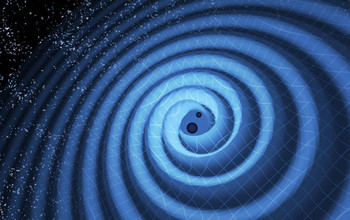All Images
News Release 16-072
Gravitational waves detected from second pair of colliding black holes
LIGO Scientific Collaboration and Virgo collaboration identify second gravitational wave event using data from Advanced LIGO detectors
This material is available primarily for archival purposes. Telephone numbers or other contact information may be out of date; please see current contact information at media contacts.

This illustration shows the merger of two black holes and the gravitational waves that ripple outward as the black holes spiral toward each other. The black holes -- which represent those detected by LIGO on Dec. 26, 2015 -- were 14 and eight times the mass of the sun, until they merged, forming a single black hole 21 times the mass of the sun. In reality, the area near the black holes would appear highly warped, and the gravitational waves would be difficult to see directly.
Credit: LIGO/T. Pyle
Download the high-resolution JPG version of the image. (831.6 KB)
Use your mouse to right-click (Mac users may need to Ctrl-click) the link above and choose the option that will save the file or target to your computer.
This artist's animation shows the merger of two black holes and the gravitational waves that ripple outward during the event. The black holes -- which represent those detected by LIGO on Dec. 26, 2015 -- were 14 and 8 times the mass of the sun, until they merged, forming a single black hole 21 times the sun's mass. One solar mass was converted to gravitational waves. In reality, the area near the black holes would appear highly warped, and the gravitational waves would be difficult to see directly.
Credit: LIGO/T. Pyle
Download the high-resolution JPG version of the image. (47.6 KB)
Use your mouse to right-click (Mac users may need to Ctrl-click) the link above and choose the option that will save the file or target to your computer.
The best-fit models of LIGO's gravitational-wave signals are converted into sounds. The first sound is from modeled gravitational waves detected by LIGO on Dec. 26, 2015, when two black holes merged. This is then compared to the first-ever gravitational waves detected by LIGO on Sept. 14, 2015, when two higher-mass black holes merged. This sequence is repeated. The pitch of both signals is then increased, allowing them to be heard more easily, and this sequence is also repeated.
Credit: Animation: LIGO
Download the high-resolution PNG version of the image. (1.1 MB)
Use your mouse to right-click (Mac users may need to Ctrl-click) the link above and choose the option that will save the file or target to your computer.


